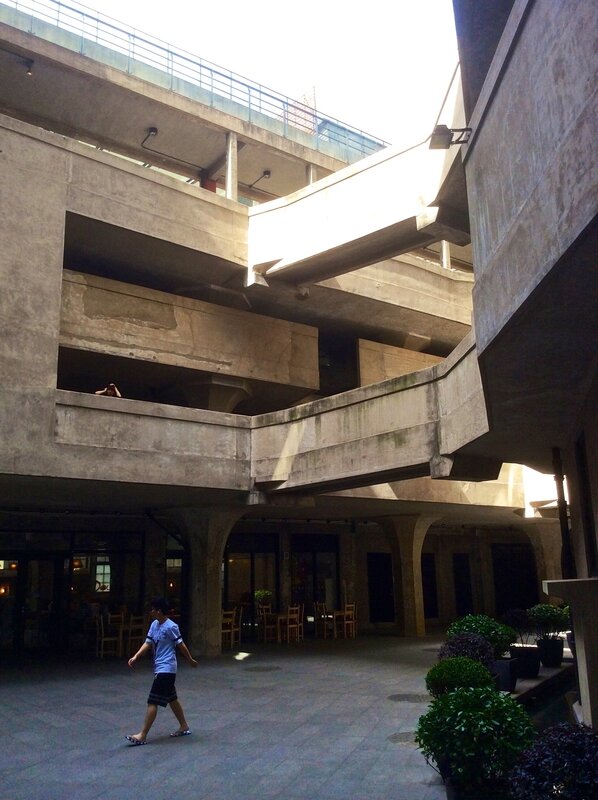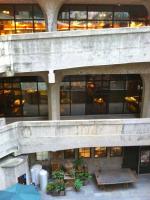1933 and beyond!
Those who know me can testify that I am not really fond of dreadful or gloomy places. So they might be surprised by my commenting of a former slaughterhouse in Shanghai.
The 1933 Old Millfun, as it called, is indeed the former largest slaughterhouse in Asia and was build, as its name suggests it, in 1933 by British architect Balfours. The place is not only famous for its and dull past but more for its more recent transformation into a most trendy and fashionable venue in Shanghai. 1933 has indeed a great concentration of galleries, designers offices and proposes events in the field of arts and fashion.
This is also a place for Shanghai Art-Deco lovers as 1933 slaughterhouse layout is definitely referring to this particular style, using geometrical shapes, innovative enlighting patterns and concrete structures to connect the different parts of it. Talking about architecture, the former Shanghai Municipal Slaughterhouse is a unique combination of industrial usage and esthetics to serve the needs of the time: a unit capable of ensuring both hygiene requirementss as well as the supply of meat for the fast growing population of Shanghai 30’s.
When Hankou was called "Little Tokyo"
If we want to understand why such a building was created, we have to get back to the end of the 19th century when the whole neighborhood was American ruled, but Japanese populated. At this period, the Hankou district concentrated immigrants from both China and Japan, looking for opportunities in the rising economic capital of the East. Factories concentrated on the river banks would manufacture cotton, tobacco or weaponery and provide the new comers with thousands of jobs. Up to 30000 Japanese and at least one million Chinese squatted this part of the city.
Around 1881, the Shanghai Municipal Council which ruled the area decided to build a first slaughterhouse that could supply local needs for fresh meat. This one was built in bricks and could provide meat at a daily rate of 72 oxen, 107 sheeps and 40 pigs. Unfortunately, this first equipment was quickly outdated and new solutions had to be found to cope with the fast-growing figures and guaranty a healthy supply of fresh meat.
The largest slaughterhouse in Asia
The Shanghai Municipal Council therefore decided to buid near the Hankou Port on Shaxing Road a brand new structure using the most modern techniques in both architecture and industry. The new slaughterhouse started operating at the end of 1933 with a daily capacity of 1000 oxen, 1700 sheeps and 300 pigs, being able to store some 410 tons of fresh meat in its huge coolers. The building also used a laboratory to check on the animals health before they were killed as a way to prevent epidemics.
Architecture-wise, the four storey building used concrete and and a modern distribution of space with minimum distance for men and maximum space for animals. The specific use of light through large panels of cercles in the front face of the structure enables the some 80 employees to work in day-light. The Art-Deco style definitely inspired British architect Balfours to optimize the shapes, using elevated corridors to connect the different sections of the building. Although the building was never painted, the harmonious use of geometric figures gave it a balanced and aerian style.
 Looking at the techniques, the new factory was equiped with electric trains to facilitate the handling and circulation of heavy quarters of meat. The fourth floor used dehairing machines for pigs to fasten the conditionning process. The central part was dedicated to the circulation of men whereas the animals would be stabbled on sides depending on their health condition and species. Close to the Hankou harbor, logistics could also be optimized and boat transportation of living animals was possible.
Looking at the techniques, the new factory was equiped with electric trains to facilitate the handling and circulation of heavy quarters of meat. The fourth floor used dehairing machines for pigs to fasten the conditionning process. The central part was dedicated to the circulation of men whereas the animals would be stabbled on sides depending on their health condition and species. Close to the Hankou harbor, logistics could also be optimized and boat transportation of living animals was possible.
History keeps going on
The factory history followed the one of China: in 1937, the Japanese troops take over the former American part of the International Settlement including the Hankou harbor. The wartime period meant a quasi standstill for the slaughterhouse as Shanghai was blocaded by both Chinese nationalist ships and American bombardments. Meat was therefore almost impossible to be found in town. In 1945, under Chiang Kai Shek rule, the place became The Number One Shanghai Slaughterhouse and it was again debaptised four years later when communists won over China into Shanghai North Slaughterhouse, adding then chicken, rabbits and even medecine production to its basic activities. In 2002, the factory definitely stopped its business, not being able to meet modern standards anymore.
A new usage of the building has been found in 2007 with the renovation into a large design and commerce center, gathering restaurants, cafes together with multifunction spaces for events. The world famous sports car brand Ferrari inaugurated the place with a most mediatized party in late 2007 and from this time on, the former factory has been chosen for photo-shootings and fashion events. It is also a pleasant place to visit for its eye-catching perspectives and an excellent starting point to discover nearby former Japanese and American heritage that I will have the pleasure to introduce in a coming article.
History is not about continuity, it is about transformation. Then again Shanghai keeps surprising us as a living exemple of the world history in motion. 1933 Old Millfun offers a perfect illustration of it.
If you want to know more you can contact me at 15021769130 or didier.pujol@chinaworldexplorers.com










/http%3A%2F%2Fstorage.canalblog.com%2F58%2F61%2F1091491%2F101692871_o.jpg)
/http%3A%2F%2Fstorage.canalblog.com%2F65%2F29%2F1091491%2F97874313_o.jpg)
/https%3A%2F%2Fprofilepics.canalblog.com%2Fprofilepics%2F1%2F0%2F1001591.jpg)